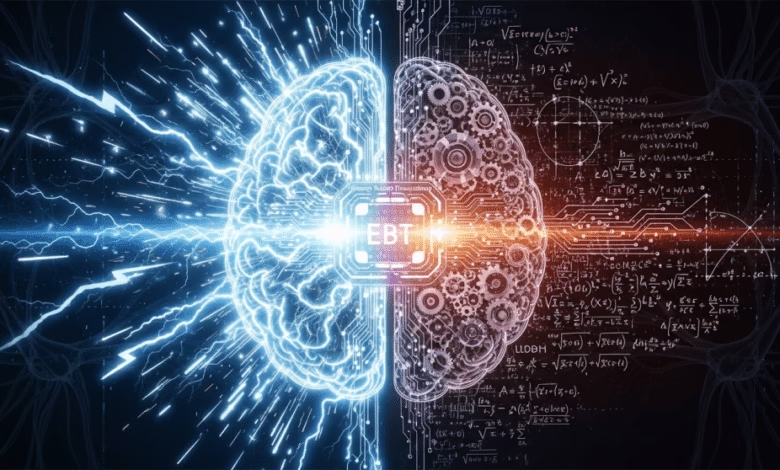AI Breakthrough: ‘Thinking as Optimization’ Boosts General-Purpose Models

▼ Summary
– Researchers developed an energy-based transformer (EBT) model architecture to enhance AI reasoning and robustness, potentially enabling cost-effective applications that generalize to novel situations.
– Current AI models excel at fast, intuitive tasks (System 1 thinking) but struggle with slow, analytical reasoning (System 2 thinking), which EBTs aim to address.
– EBTs use an energy-based approach where the model verifies and refines predictions, allowing dynamic compute allocation and better handling of uncertainty and unfamiliar scenarios.
– EBTs outperformed traditional models in efficiency (35% higher scaling rate) and reasoning tasks (29% better performance), while also improving generalization, especially for out-of-distribution data.
– The architecture is compatible with existing hardware and frameworks, making it a practical drop-in replacement for current LLMs, with potential benefits for enterprise applications requiring critical decisions or limited data.
Breakthrough AI Architecture Unlocks More Powerful Reasoning Capabilities
A new approach to artificial intelligence could lead to systems that think more like humans, solving complex problems with greater efficiency and adaptability. Researchers from the University of Illinois Urbana-Champaign and the University of Virginia have developed an energy-based transformer (EBT), a model architecture that enhances reasoning by treating thinking as an optimization process. This innovation could pave the way for AI that generalizes better, reduces costs, and handles novel challenges without requiring extensive fine-tuning.
The Challenge of Advanced AI Reasoning
Human cognition operates in two distinct modes: fast, instinctive thinking (System 1) and slower, deliberate reasoning (System 2). While today’s large language models (LLMs) excel at System 1 tasks, like quick text generation, they struggle with System 2 challenges that demand deeper analysis. Current methods to improve reasoning, such as reinforcement learning or best-of-n sampling, have limitations. They often work well only on narrow, verifiable problems like math or coding, while faltering in creative or exploratory tasks. Worse, these techniques may not actually teach models new reasoning skills, they simply reinforce existing patterns.
A New Approach: Energy-Based Models
The EBT architecture introduces a fresh perspective by leveraging energy-based models (EBMs). Instead of directly generating answers, the model learns an energy function that evaluates how well a prediction fits a given input. Low energy means high compatibility, while high energy indicates a poor match. This allows the AI to refine its responses iteratively, optimizing for the best solution rather than guessing outright.
The key advantage? Verification is often easier than generation. By treating reasoning as an optimization problem, EBTs dynamically allocate computational resources, spending more “thinking time” on harder problems and less on simpler ones. They also eliminate the need for external verifiers, functioning as self-contained systems that assess and improve their own outputs.
How Energy-Based Transformers Work
To overcome scalability issues with traditional EBMs, the researchers introduced EBTs, specialized transformer models designed for this framework. These models first verify the compatibility between a prompt and a potential answer, then refine their predictions to find the lowest-energy (most accurate) solution. Two variants were developed: a decoder-only model (similar to GPT) and a bidirectional model (akin to BERT).
In testing, EBTs outperformed conventional transformers in both efficiency and reasoning ability. During pretraining, they achieved 35% higher scaling rates, meaning they learned faster with less computational expense. At inference time, their ability to “think longer” and self-verify improved language modeling performance by 29% compared to standard transformer models.
Real-World Advantages for Enterprise AI
The implications for businesses are significant. EBTs demonstrate stronger generalization, performing better on unfamiliar tasks, a crucial trait for real-world applications where data distribution often shifts. They also require less high-quality training data, a major advantage as data scarcity becomes a bottleneck in AI development.
Compatibility with existing infrastructure makes EBTs practical for deployment. They can run on standard hardware (GPUs, TPUs) and integrate with optimization techniques like FlashAttention-3 and inference frameworks such as vLLM. For enterprises, this means AI systems that make more reliable decisions in critical areas, such as safety-sensitive applications or scenarios with limited training data.
The Future of AI Reasoning
As foundation models grow larger, the benefits of EBTs could become even more pronounced. The researchers predict that at massive scales, EBTs will significantly outperform traditional transformers, offering better performance with fewer resources. This breakthrough suggests a path forward for AI that doesn’t just mimic human thought but optimizes it, ushering in a new era of intelligent, adaptable systems.
For developers and businesses, EBTs represent a promising foundation for the next generation of AI, one where machines don’t just generate answers, but truly think through problems.
(Source: VentureBeat)